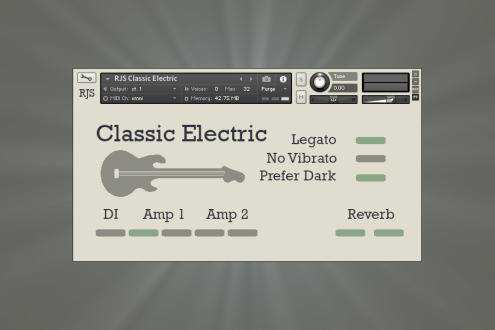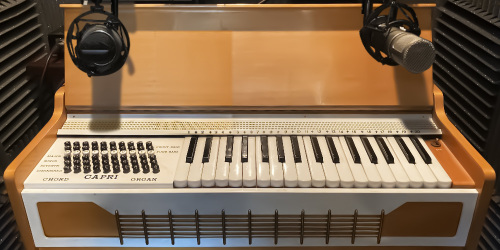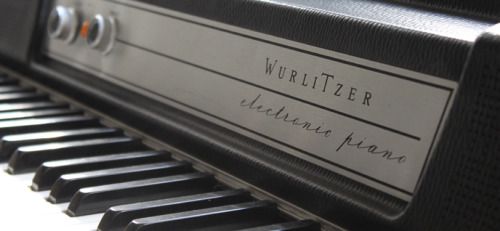
LoFoMusic
LoFoMusic’s Reviews

Deep Sampling of a Classic Guitar!
The Library
--------------
A finger-picked electric guitar library, covering almost 4 octaves, and implementing a range of articulations, e.g., legato, palm muting, dead notes, slides, and more. Also, a separate instrument that allows you to play major/minor chords with several articulations (e.g., regular, muted, power chords).The Samples
----------------
The samplist (Risto) has put in some significant time with this library, recording a deep range of samples. Main sample groups include: Normal (w/vibrato), No Vibrato, Palm Muted, Dead Notes, Up/Down Slides, Legato transitions (semitone & whole tone, up & down), Dead Strums, Noises, and Releases. The groups most prone to be played 'short' (i.e., no vibrato, palm muted) include 3 round robins. He also sampled part of the guitar at a different place on the neck, allowing the player to switch to different 'neck routes' via keyswitching for a brighter or darker tone. So many options, and including over 600 samples(!). And this is just for the Classic Guitar instrument.The Chords instrument includes the following sample groups:
Major Up, Major Down, Minor Up, Minor Down,
Power Chords Up, Power Chords Down,
Palm Muted Power Chords (4 round robins), and
Palm Muted Single Notes Up & Down (4 round robins each).
Another 108 samples to accomplish this!The Instruments
-------------------
The 'Classic Electric' instrument is for playback of the single note samples, and it is set up to encourage arpeggios and simple solo lines. Besides the keyswitching to access the various articulations (see the handy diagram Risto includes in the files!), it allows you to turn on/off legato, turn on/off vibrato, and change the 'neck routing' to give you a slightly brighter or darker tone.The 'Guitar Chords' instrument is set up to quickly play strummed chords, palm muted chords, and palm muted single notes, again via keyswitching.
And, then, both instruments have buttons to bring in several amp tones and reverb settings.
What I Liked
---------------
I like many things about this instrument. First off, that the samplist put so much time/energy/effort into packing this instrument with so much musicality.Secondly, it is so playable and usable, in so many ways, and in so many genres. From simple arpeggiation, to palm muted power chords, to dead notes/strums, to solo lines, the library gives you a broad reach.
Third, it gives me a new appreciation for how much you can offer to the Pianobook community, even in a free instrument. Thanks, Risto! I am grabbing up your other instruments, also, and learning from them as I approach making my first sample library.
What I Would Wish For
---------------------------
Not much to say here, I like virtually everything about the library, especially the Classic Electric library (I'm a sucker for arpeggiated guitar). Maybe some more detailed documentation around 'neck routing'...? I found this part hard to understand, at first, and even had to ask questions to the samplist so I (hopefully) didn't mess up the explanation in the review.Overall - this is one of the very best implementations I have seen in Pianobook, and better than many paid libraries. Keep it coming, Risto!

This one is a keeper!
What you get:
The full keyboard (34 keys), sampled by minor 3rds.
3 vel levels + release triggers.
2 microphones (Neumann TLM-102 + Sterling Audio ST-66).
+ bonus: sound of The Capri turning on, and then off.
100 samples total.What I liked:
- the GUI is very evocative. I feel like I'm sitting down to the instrument as I look at it.
- the sampling is simple, but complete. even down to the release triggers and background fan noise.
- the sounds are very usable, especially to somebody like me (I happen to really like using the sound of non-portable harmoniums in neoclassical settings). mellow enough, but can also cut through the mix as a lead instrument.
- the 'extras' added (right/left mics, 'mood', 'ambience') give the instrument enough give/take to be tailored to taste right from the GUI.What I Wish For:
Not a thing, really. This is a great effort. I suppose some might wish for the 'chord section' (to the left) to be sampled/included...? I myself would not, because I suspect (but don't know for sure) that the chords in a section like this would be rather dense, and those can often be grating, even when incorporating a nice solo tone.
Thanks for this instrument, Taylor! I will be keeping it, and using it, for sure!

Fantastic Tuned Percussion Library!
What You Get
----------------
Soprano, alto, tenor Orff xylophones - sampled in mono & stereo -
2 velocity levels (VLs), with 3 round-robins (RRs) at the softer level.
Orff mini xylophone -
2 VLs, with 3 RRs at each level.
Metallophone - sampled with regular and 'muted' articulations -
2 VLs, with 3 RRs at each level.
Chime - sampled with 'mallet', 'muted', and 'stick' articulations -
2 VLs.
576 samples total - lot of great sampling work!All wrapped up in a Kontakt instrument that is fully kitted out with:
- volume controls for each of the instruments/elements
- on/off buttons for the various chime articulations
- volume controls for both dry & pedal-processed sounds
- a fully-functioning sequencer (up to 64 steps, with adjustable note-order, direction, rate, duration, swing, octave, repeats, and latching capability).
- reverb & delay controlsThe samplists have provided a 'Master' patch, and then also 125+ presets that you can use to fully explore all the modulation, distortion, delay, and miscellaneous experimentation they got into!
What I Liked
--------------
Virtually everything about this library! I love tuned percussion, one of the perfect counterparts to a pad/drone, and useful in so many genres. A pile of capabilities in this one instrument, all at the fingertips. Hard to believe you can gain so much potential for music-making from 'children' or 'student' instruments.What I Would Wish For
---------------------------
Hardly anything I could mention. This is a super-very-well-done instrument, from the sampling to the processing to the most-excellent GUI/controls.One little bug(?) I found - in the '01 Master' instrument, I could not get the 'Pedals' volume control to bring up any processed sound. I believe it's in the instrument, not just on my system, because I tried it on my Mac Mini and my Macbook Pro -- same results. However, I found that if I bring up one of the presets, I can get both the Dry and Pedal volume controls to work, and can go from there.
Thanks, Sam & Obolig for this excellent library. It's certainly a keeper!

Great Sampling of a Classic EP
What you get:
Deep-sampled Wurlitzer EP
---------------------------------
all 88 keys x 3 vel layers
+ release triggers
+ pedal sounds
+ key noise
+ 'wobbly' treated sounds + granular treated sounds
= 452 samples, totalWhat I liked (a lot!):
-----------------------
- Very playable, very characterful Wurlitzer sound. Just the right amount of 'dirt' in it, for me.
- And then the ability to add some 'wobble' (and stereo width?),
some granular interest, and some delay/reverb. Nice UI control over
these things.
- Also, the ability to add some envelope/filtering, which I found very useful
when turning the 'EP' into more of a 'pad'.
- Daniel took the time to bring us 5 patches, each of which shows off a different aspect of the instrument: 1) regular Wurli, 2) Wobble, 3) Granular, 4) Toy (just the mechanical sounds from the key/release noise), and 5) Dream (pad-like). With skins for each, evoking the mood!
- Daniel also did a great video explaining not only the story, but also all the UI controls. Great!What I would wish for:
--------------------------
The only thing missing here is some round-robins on the regular Wurli samples. I suppose, with work, pseudo-round-robins could be provided by tuning down and repurposing adjacent samples, especially since Daniel took the time to sample every key.Otherwise, I can't think of any constructive feedback. This is already a really nice instrument! I have a pile of Wurlitzer libraries already, but I could see myself using this one, because it's so playable and editable so quickly. A bit of wobble, a dab of granular, some delay/verb, and there ya go. Thanks, Daniel!
Great concept, generous content!
I'll do something here a bit different from my normal reviews.
Instead of doing a deep dive into the library (I think Martin explains it
quite adequately), I just want to make a few quick comments about the library, and then answer 'TheGreatOz's question.- First, I'm always impressed with the work that Martin puts into his sample libraries. Never one to give us a one-sound instrument, he is quite generous with the depth/breadth his libraries provide, and he is here, also.
- Secondly, I simply love the way he has combined nature, physics, and music together in this library. This is one of those 'man I wish I had thought of this' libraries.
- To TheGreatOz - I believe Martin meant for several of the sliders to be absent. Note in his comments that he alludes to a paid version of this library that has 'more evolving soundscapes and musical instruments'. That paid version has a working slider on each of the pads/sounds.
(it would be nice, in my opinion, if the pads/instruments that are not available on the free version would be grayed-out, or put in italics, or something like that, to denote that they are not available (or supposed to work).
All in all, a great effort, and, especially to a fellow scientist/engineer/musician, very engaging. Thanks, Martin!
